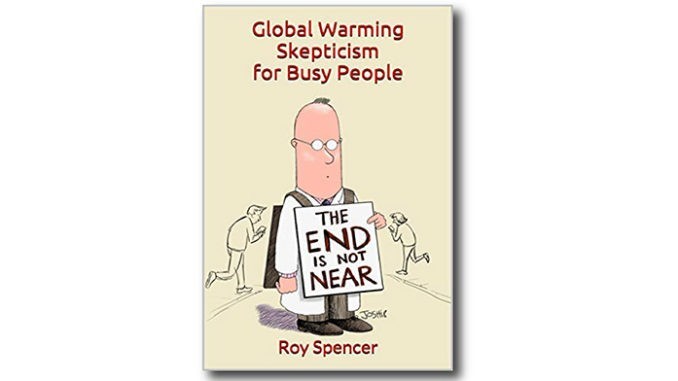
“Global Warming Skepticism for Busy People” written by Dr. Roy Spencer is available on Kindle.
Dr. Spencer is a Principal Research Scientist at the University of Alabama in Huntsville. Formerly he was a Senior Scientist for Climate Studies at NASA’s Marshall Space Flight Center, where he and Dr. John Christy received NASA’s Exceptional Scientific Achievement Medal for their global temperature monitoring work with satellites. Dr. Spencer’s work with NASA continues as the U.S. Science Team leader for the Advanced Microwave Scanning Radiometer flying on NASA’s Aqua satellite.
The following review was written by Ken Haapala, President, Science and Environmental Policy Project (SEPP) It is slightly edited. (Source)
Spencer wrote an exceptional book on the issues between knowledge and speculation as applied to climate science. Well written and easy to understand, the book discusses basic components of the major issues. It presents evidence from both sides, emphasizing that the greenhouse effect is well established, but the positive feedbacks are not. The fear of CO2 as promoted by the IPCC and others is attributed to the feedbacks. The book briefly discusses the benefits and costs of increasing CO2, with the costs lacking physical evidence, such as increasing sea level rise and ocean acidification.
Spencer asks five big questions:
1) “Is warming and associated climate change mostly human caused?
2) Is the human-caused portion of warming and associated climate change large enough to be damaging?
3) Do the climate models we use for proposed energy policies accurately predict climate change?
4) Would the proposed policy changes substantially reduce climate change and resulting damage?
5) Would the policy changes do more good than harm to humanity?
Spencer: “The answers to all five questions need to be ‘yes’ in order to make substantial changes to our energy policies beyond what free market forces dictate. Yet, it is not obvious to me that the answer to any of the five is ‘yes.’”
Among the many issues he raises are the accuracy of natural energy flows, which are not well known. Without compiling knowledge from measurements, not calculations used in unvalidated models, we cannot establish that the warming from a doubling of CO2 will be different than a modest 1.2 º C, far less than claimed by the IPCC.
To achieve a doubling of CO2 from the current level of slightly over 400 parts per million (ppm) would require burning more fossil fuels than are known to exist in the world. Furthermore, it is doubtful that even this would be sufficient to prevent an inevitable future ice age, a true killer climate.
Spencer points out that just because a research paper assumes the cause of warming is CO2, it is not necessarily true, then states:
“Why don’t more papers tackle the thorny issue of determining how much warming is natural versus anthropogenic? For at least three reasons:
1) We cannot separate human from natural causes of warming (there are no human fingerprints).
2) We have only a poor understanding of natural causes of climate change.
3) We cannot compute how strong human-caused warming is from first physical principles (the climate sensitivity problem, discussed later).
Chapter 13; Why is Warming not Progressing as Predicted? addresses the big problem of IPCC’s reliance on climate models in its policies.
“Climate models [in use today] probably over-predict warming because they[the models] produce too much positive feedback, which is necessary for high climate sensitivity. The small amount of direct warming from a doubling of CO2 (a little over 1 deg C) is magnified by about a factor of three in climate models due to warming-induced changes in clouds and water vapor, while the [actual] observations suggest there is little magnification at all.
“The positive feedback processes contained in climate models are very uncertain, yet are responsible for most (about 2/3) of the warming the models produce.
While the models are indeed mostly made up of fundamental physical principles that are pretty well established, it is these few poorly known feedback processes that determine how serious the global warming problem will be. Out of hundreds of thousands of lines of computer code making up the models, it could be that only a few lines of code representing very uncertain assumptions about the climate system are mainly responsible for producing too much [predicted] warming.
“This is why I call the climate research community’s defense of the current climate models as ‘bait and switch’. The well-understood basic physical principles the models are built on produce only about 1 deg. C of warming in response to 2Xco2, [a doubling of CO2] while the additional 2 deg. C of warming they produce from positive feedbacks is very speculative. They sell you on the well understood physics supporting the 1 deg. C of direct warming, but then switch to the full 3 degrees of warming the models produce as similarly reliable.
“How clouds might change with warming (cloud feedback) is particularly uncertain, a fact that is admitted by modelers. The climate models cannot include the actual physics of cloud formation and dissipation because computers are not nearly fast enough to be run with the fine detail contained in clouds. In fact, we don’t even understand some of the microphysical details of what happens in clouds, preventing us from modelling them even if computers were fast enough.”
According to Spencer the models have clouds forming at a humidity as low as 85% but in reality, they require a relative humidity of 100%. This is but one of many issues with the efforts to model the climate. To depend on the results of such modeling in establishing energy policy is absurd.
There are a number of good books on the weaknesses of climate science proclaimed by the IPCC and its followers. This is one of the finest.

As an aside, using Spencer’s numbers and IPCC’s logic one could say that the IPCC’s science is one-third science and two-thirds science fiction.
Note to readers:
Visit my blog at: https://wryheat.wordpress.com/
My comprehensive 30-page essay on climate change: http://wp.me/P3SUNp-1bq
A shorter ADI version is at https://arizonadailyindependent.com/2013/08/01/climate-change-in-perspective/
Climate Change articles by Jonathan DuHamel
Global Warming – The Madness of our Age (CM1)
Climate madness 10
Climate Craziness, Politics, and Hypocrisy (CM11)
